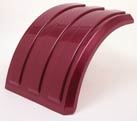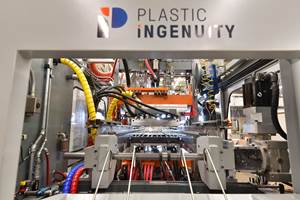Thermoforming Shines in Exterior Vehicle Panels
Thermoformers are gaining a foothold in large exterior panels of specialized automobiles and utility vehicles.
Thermoformers are gaining a foothold in large exterior panels of specialized automobiles and utility vehicles. In these applications, thermoforming is replacing steel, aluminum, glass-reinforced composites, and sometimes even injection molded plastics. Thermoforming benefits from auto makers’ desire to “mass customize” or “personalize” vehicles in design and color. This favors thermoforming because it is able to deliver tools more rapidly and at lower cost than most established fabrication methods. These trends were evident in a number of parts displayed at the SPE Thermoforming 2002 conference and exhibition held recently in Nashville, Tenn.
Increased mastery of TPO thermoforming is one factor in this automotive success story. TPOs are low-density, cost-effective materials, but they have been difficult to form due to their relatively low melt strength.
A second opening for thermoforming springs from improvements in combinations of ABS sheet with a weatherable cap layer that can provide high-quality—even Class A—decorative performance. Vehicle makers favor this integral-color approach because it bypasses the cost and environmental challenges of painting.
In one novel application, a thermoformed decorative skin provides surface aesthetics without paint while glass-reinforced polyurethane gives the structural support.
TPOs in high gear
A striking success in TPO thermoforming is a front bumper fascia for a Renault car made in Colombia for the regional market. The painted, 0.24-in.-thick part includes severe undercuts 1 in. deep at each end.
Renault’s goals in shifting from injection molded to thermoformed TPO for the fascia were to reduce tooling costs in a program calling for just 7000 parts a year. Washington Penn Plastic Co. supplied the TPO. The thermoformer is Thermoform S.A. in Cajica, Colombia. Industry sources say delivery time for an injection tool would have been far longer and the initial cost four or five times higher than with thermoforming.
Innovative tooling and extensive process development were critical to the program, notes Art Buckel, a San Diego-based consultant with McConnell Co., who worked on the project. Thermoform S.A. used a European closed-chamber style machine that Buckel says ensured highly uniform wall thickness.
“This tool breaks new ground,” declares Fritz Borke, v.p. of Borke Mold, builder of the temperature-controlled aluminum tool. It incorporates moving sections at each end that slide up wear-resistant bronze ramps fitted with special guides, a design that makes it feasible to form the deep undercuts and demold the parts.
Meanwhile, Solvay Engineered Polymers, a TPO compounder, announced other recent inroads in thermoformed and painted TPO exterior vehicle panels. According to Eric Short, TPO market-development manager, areas especially amenable to TPOs include aftermarket parts like running boards and tonneau covers, as well as truck and trailer panels like fenders and end caps. Both sectors, says Short, involve relatively modest volumes and a plethora of custom colors. In addition, he says TPO for thermoforming costs less than coextruded ABS/ASA sheet.
Short cited the example of Spray Control Systems in Blooming Prairie, Minn., which thermoforms truck fenders of Solvay’s Dexflex E118 TPO. These truck fenders are said to provide superior low-temperature impact resistance and painted surface quality equivalent to that of the glass-reinforced composites commonly used in this application.
In the automotive aftermarket, one success is a running board for Ford vehicles thermoformed by TPi (the former Thermoform Plastics Inc.) in St. Paul, Minn. Switching to a Solvay TPO in this abuse-prone application provided outstanding low-temperature ductility and stiffness, says Roger Jean, TPi’s national sales manager. Since the part is offered in 50 custom colors, painting is the lowest-cost decorating method.
Industry sources expect the next stage in TPO forming to include parts that are decorated by means of weatherable, high-gloss paint films or coextruded capstocks as a substitute for painting. TPi’s Jean says challenges remain in the areas of TPOs’ limited bondability and draw ratios.
Nevertheless, a glimpse of the future was provided by TPO compound supplier Equistar Chemicals, which showed a thermoformed TPO rocker panel said to be approved for a 2004 model-year introduction planned by one North American car maker. This breakthrough part achieves Class A surface finish via a dry, formable paint film laminated to the TPO. Equistar is also developing TPO grades optimized specifically for sheet extrusion and thermoforming.
Thermoformed roofs
An automotive roof panel displayed in Nashville was produced by Detroit-based ArvinMeritor LLC for the Micro Compact (MCC) Smart Car launched in early 2002 by a subsidiary of DaimlerChrysler in Germany. The part uses a novel combination of Paintless Film Molding (PFM) and the Long Fiber Injection (LFI) polyurethane process from Krauss-Maffei. Thermoforming was used to create weatherable, decorative thermoplastic inserts that are subsequently back-molded with a 30% long-glass reinforced polyurethane. Comparable to SRIM, the LFI process chops continuous glass rovings in the RIM mixhead and deposits the resin and glass in an open mold with a robotic traversing head.
The breakthrough, says Karim Dayoub, advanced engineering supervisor at ArvinMeritor, is the ability to give a Class A surface to SRIM without painting. The module reportedly meets demanding structural requirements and has lower cost and CLTE than painted alternatives like aluminum and compression molded SMC.
What made this advance possible is a paintless, 0.5-in.-thick coextruded sheet of ABS/ASA/PMMA from Senoplast Klepsch & Co. in Austria. The easy-to-handle film (it has a removable protective layer) is thermoformed, trimmed by a jointed-arm robot, and back-molded in a continuous sequence of operations. Thermoforming equipment is supplied by Geiss Machinenfabrik in Germany (which has a new U.S. direct-sales office).
The PFM insert provides striking metallic black or silver decorative effects and Class A surface quality, Dayoub says. The deep-draw panel integrates ribs, studs, and other features. It is about 250% stiffer and 30% lighter than aluminum. The design also integrates the antennae and other electronics into the roof.
“This opens other opportunities in thermoformed exterior vehicle panels,” says Mike Reeves, film sales director at Senoplast USA. He cites hoods, rocker panels, and tailgates as examples. And apart from thermoforming, he expects Senotop paintless films to catch on in large, abuse-prone, structural exterior parts made by compression or injection molding.
Weatherable coextrusions
In Nashville, GE Plastics showed off thermoformed, unpainted exterior panels for a growing category of utility vehicles called Neighborhood Electric Vehicles. NEVs are low-speed vehicles designed to replace conventional mail trucks, mini-buses, and golf carts.
One of these is the Global Electric Car (GEM) made by Global Electric Motorcars LLC in Fargo, N.D., now a subsidiary of DaimlerChrysler. GEM vehicles require weatherable exterior panels with glossy surfaces and high-quality coloring, although their requirements fall short of automotive Class A. GE Plastics worked together with Spartech Corp., which coextruded the two- and three-layer sheets for the GEM. TPi was one of several thermoformers of the panels.
GEM roof and other horizontal panels utilize Spartech’s WeatherPro G, a new tri-layer sheet of an ABS substrate, ASA color layer, and acrylic-based capstock. The ASA layer carries either metallic or solid colors and provides good uv protection and color consistency. The clear capstock accentuates depth of color and imparts scratch resistance, high gloss, and gloss retention. Vertical panels use a Spartech ABS/ASA sheet that has low gloss, weatherability, and good stiffness-toughness balance. Spartech also plans to launch some coextruded, weatherable TPO sheet products shortly.
Another advocate of unpainted thermoformed ABS/ASA parts is Bayer Corp. Bayer says these materials are a growing challenge to glass-fiber composites in non-automotive transport vehicles. Glenn Teer, Bayer’s extrusion account manager, cites a rear panel of a recreational vehicle thermoformed by Duoform Plastics in Edwardsburg, Mich. ABS/ASA affords a smooth, glossy, weatherable surface comparable to painted SMC, yet requires no painting and uses a lower-cost aluminum tool, according to Tom Werts, Duoform’s v.p. for marketing and new-product development. Other payoffs include weight and cost savings, and the elimination of VOC emissions from the SMC resin and paint.
Bayer’s materials are also being used in 5-ft-long golf-cart roof panels thermoformed by Piper Plastics in Orlando, Fla. The panels are formed from 0.188-in. ABS/ASA sheet.
Related Content
Ingenuity Is Part of This Former’s Name, and in Its DNA
Plastic Ingenuity started in a garage in 1972 and through a commitment to developing best-in-class products stands today as one of the largest custom thermoformers in the world.
Read MoreSheet Extrusion, Thermoforming Tips for PLA/aPHA Blends
Biopolymers like PLA and PHA are able to meet sustainability goals while also delivering the performance attributes needed in rigid food packaging. Here’s what testing has shown.
Read MoreExxonMobil Develops High-Performance, 95% PE Recyclable Thermoformed Packaging
The packaging solution involved a collaboration with equipment suppliers Hosokawa Alpine and Multivac Group.
Read MoreThermoformed Container Keeps Battery Cells Safe
Despite last-minute design changes and other unexpected roadblocks, thermoformer TriEnda works with a key supplier on innovative reusable shipping container.
Read MoreRead Next
For PLASTICS' CEO Seaholm, NPE to Shine Light on Sustainability Successes
With advocacy, communication and sustainability as three main pillars, Seaholm leads a trade association to NPE that ‘is more active today than we have ever been.’
Read MoreMaking the Circular Economy a Reality
Driven by brand owner demands and new worldwide legislation, the entire supply chain is working toward the shift to circularity, with some evidence the circular economy has already begun.
Read MoreLead the Conversation, Change the Conversation
Coverage of single-use plastics can be both misleading and demoralizing. Here are 10 tips for changing the perception of the plastics industry at your company and in your community.
Read More























